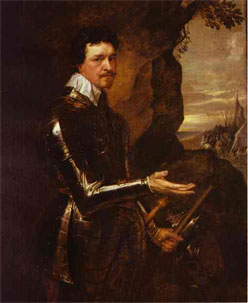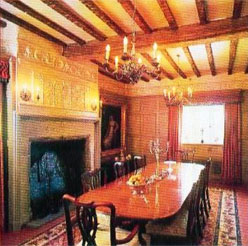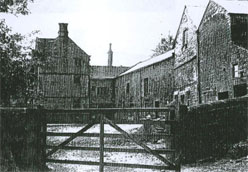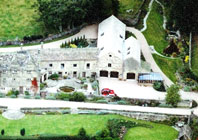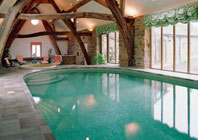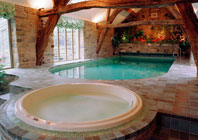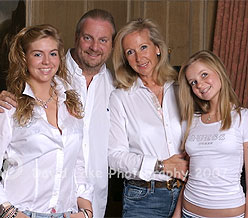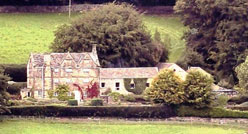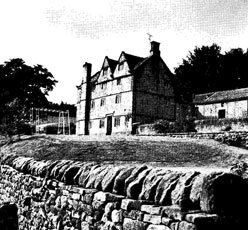History of Hallfield House
The site of Hallfield is an ancient one and occupation can be dated back with documentation to the 13th Century.
In 1270, Thomas Ffurnival, the son of Lord Thomas Ffurnival granted land at the head of Bradfield Dale for “the depasturing and agisting of their own propper cattle” i.e. for farming:
“Grant by Thomas, son of Thomas de Ffurnival, son of John de Whyteles, his heirs and assigns, excepting religious and Jews, of a messuage with appertenances, called Hallefelde in Thornsette in the soke of Bradfield, just as it lies in length and breadth without curtailment; to hold of the grantor and his heirs freely, peacefully and hereditorily, with all liberties and easements and rights of pasture in Hawksworthe for his own beasts and their food … paying yearly to the grantor and his heirs 3s 6d at the Assumption and Martinmas.”
The next specific reference to Hallfield is in 1318 when Adam Heggar de Romesker conveyed a piece of land called “Hallefelde in Thornsett” to one Adam Hawksworth.
On December 22nd 1440 at Sheffield Court, one Roger Tyler, the Forrester of Hallfield brought cases against William Drake for destroying young trees and Thomas de Shawe for driving swine from pannage (pasturage for pigs) of Hallfield. There are also cases brought by this Forrester for “fishing without consent” and “taking away dry wood”, so he was obviously kept busy. This Forrester was employed by the Lord of the Manor at Hallfield and he was responsible for the “maintenance of Rivelin Forest and the plentiful supply of game and boar therein” and it has been suggested that he occupied a messuage at the site where Hallfield House was eventually built.
By 1565, one Rauf Greyves (Ralph Greaves) resided at what, originally, would have been a small farm at Hallfield. He died on 8th June 1565 and in his will, proved 18th September 1565, he left his “proper lands” to his son John Greaves. Ralph Greaves lived at Hallfield with his wife Elline and their children Dyonnes, Isobel, Elline, Agnes, John and Thomas.
John Greaves lived at Hallfield with his wife Gertrude and had, in total, seven children. In 1631 John Greaves died, although his extensive and interesting will was not proved until 1692. In the Chapelry of Bradfield in the Parish of Ecclesfield in the County of York his will lists his “goods chattels and cattels”. Amongst many items, which give a thorough flavour of his life and times, this will lists a School Master’s chamber, suggesting that John Greaves was, by this time, a wealthy Yeoman Farmer.
The ownership of Hallfield then passed into the hands of his three surviving children, all daughters: Elizabeth, Mary and Ellen, all of whom were by then married ladies. Having married well, they had no need to occupy Hallfield themselves.
In 1698, one George Woodhead, formerly of Wigtwizzle became the tenant of Hallfield. He died in 1740 although his widow, Elizabeth, and her son, John Woodhead continued living at Hallfield for another 16 years. The tenancy was then passed on to one Jonathon Bacon, whose name can be found mentioned in early plans of the property.
In 1708, having no need of the house, the daughters of John Greaves sold Hallfield to Sir Thomas Wentworth of Wentworth Woodhouse. Hallfield House continued in the ownership of the Wentworth family, subsequently the Marquis of Rockingham and the Earl Fitzwilliam, for over 250 years. The house was certainly used by the Wentworth family for hunting parties for hundreds of years and one can only wonder now which historical figures may have slept here!
Hallfield House, its associated cruck barn and dovecote became Grade II listed on October 21st 1974. One fascinating detail of the listing is
“a 17th Century plaster overmantle of lilies and roses under a frieze of fish, fruit and mermaids playing harps”.
This delightful feature is now part of our dining room (see below) and again, one can only wonder who might have gazed up at this and pondered its meaning.
By September 1974, the house was quite derelict when it was offered for sale in the Sheffield Morning Telegraph:
“In need of restoration and modernisation is this most delightful Elizabethan Farm House occupying a superb situation with beautiful views to the South, over Dale Dyke and along the Loxley Valley with the open moorlands stretching to the distant horizon.
Although the property has a secluded position in the Peak District National Park, it is only a short drive from Sheffield.
The accommodation includes: a hall, 3 reception rooms, 2 kitchens, up to 12 bedrooms, a bathroom and a utility room.
Outside is a series of outbuildings including stables, barns, stores and a magnificent example of a cruck barn.
Offers around £25,000”
Immediately prior to sale by the Fitzwilliam Estate in 1974, Hallfield was occupied by the estate gamekeeper and prior to that, by a local tenant farmer.
Hallfield House was acquired in 1976 by blah blah and then by Sir Hugh and Lady Ruby Sykes in 19..
Excerpt from Henry Spencer brochure:



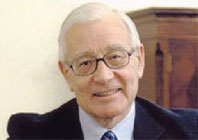
Sir Hugh has been a highly successful Sheffield business man for many years and he was born in 1932 and knighted in 1997. In a long and distinguished career, Sir Hugh has been Chief Executive of Thermal Scientific Plc, Deputy Chairman Harris Queensway Plc, Chairman of Yorkshire Bank, Chairman of Sheffield Development Corporation, Chairman of the Sheffield Galleries and Museums Trust and Deputy Lieutenant of South Yorkshire. After selling Hallfield House, Sir Hugh and Lady Ruby moved to Brookfield Manor in Hathersage.
We, the Duckenfield Family, acquired Hallfield House in May 2007 and are happily using the whole property as our family home with our two lovely daughters, Hannah and Eleanor.
Anecdotally, we have heard tell of visits to Hallfield House in modern times by the Duke & Duchess of Devonshire, Margaret Thatcher and Lady Diana Spencer.

